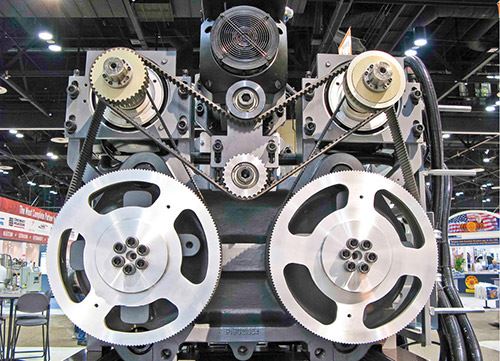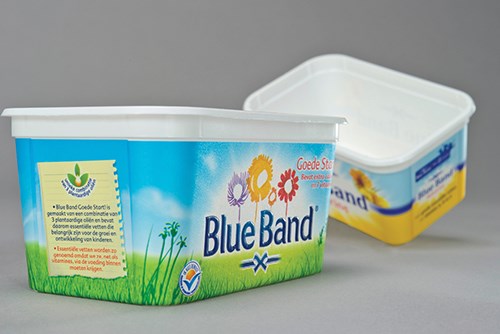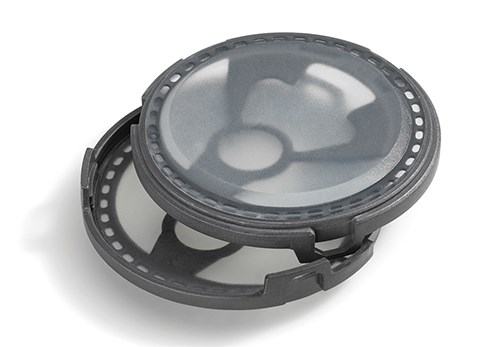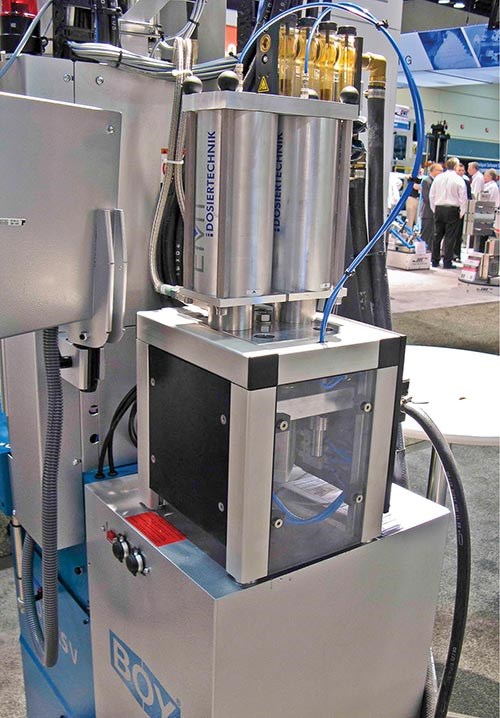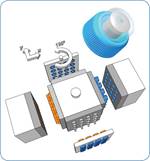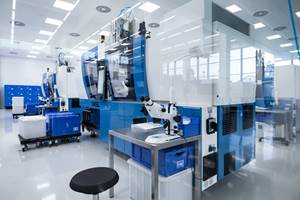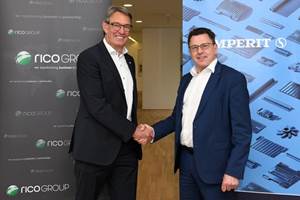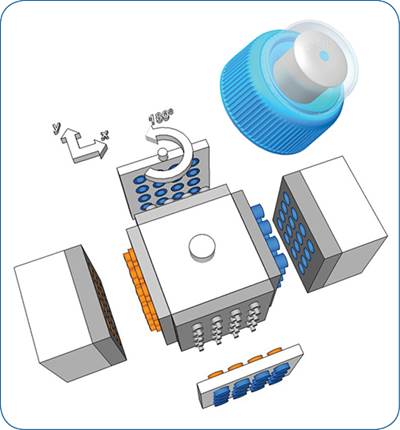NPE: New Machines Exhibit Sophisticated Molding Demos
More speed, more power, more precision, and more automated functions accomplished in and out of the mold. That’s exactly what injection machinery suppliers were offering at NPE2012.
Today’s hyper-competitive molding environment requires more—more speed, more power, more precision, and more automated functions accomplished in and out of the mold. That’s exactly what injection machinery suppliers were offering at NPE2012 in complex molding demonstrations aimed largely at automotive, medical, and packaging applications. These were some key themes of the exhibits:
•Lots of new all-electric machines, especially beefed-up models meant to prove that servos can compete in high-output packaging applictions.
•Plenty of new hybrids as well, including many space-saving two-platen models. Many “hybrids” only in the sense that servo or inverter motors drove their hydraulic pumps.
•Super-high-speed molding of caps with electric or hybrid presses and with 100% inline quality inspection.
•Multi-material molding and in-mold assembly.
•Liquid silicone rubber (LSR) molding, alone or overmolded onto thermoplastics.
•In-mold labeling (IML) becoming more sophisticated and adding more functions.
Injection molding news at the show was too voluminous to present in one article. Next month, we’ll report on controls, robots, hot runners, and other tooling developments from NPE. Also, see our March show preview for additional news that isn’t repeated here.
BEEFIER ELECTRICS FOR PACKAGING
JSW Plastics Machinery introduced all-electric models in its J-AD series from 220 to 650 tons specifically for high-speed packaging. They have reinforced bed frames to support heavy stack molds, along with linear guide rails for the moving platen and sliding shoes for stack-mold center plates. Besides 30% higher mold-weight capability, they have bigger motors, 50% faster injection acceleration/deceleration response, 24:1 mixing screw with higher rpm (yielding 20% greater PP plasticating capacity), extended daylight, 20% faster clamp movements, 20% less platen deflection, 100% greater nozzle-touch force (using a hydraulic cylinder), and greater heater capacity.
In addition, the models have 2.5X greater electrical capacity than a standard machine so they won’t overheat during high-speed molding. The regenerative braking system recovers around 6% of energy from mold open/close operations.
Maruka USA exhibited the latest all-electric model from Toyo Machinery & Metal Co. of Japan. The Si500V is a 500-ton model in the Si-V series from 35 to 940 tons. These models are beefed up with 30-40% larger servomotors than competing machines, as well as larger ballscrew systems. The series also has wider tiebar spacing and a new V-slant toggle with a greater tilt angle that reportedly provides more uniform distribution of clamp force over the platen. The upgraded System 500 controller has a 5X faster processor than before.
Milacron also showed off some new features on its PowerPAK all-electric series of 440 to 1125 tons. These include water-cooled drives and enhanced diagnostic and maintenance information on the drives in the control system, which includes a built-in energy monitor. Also new is optional high-force electric injection, designed especially for PET preforms. These machines offer optional accumulator-assisted hydraulic injection and ejection (a 330-ton model is available only in this configuration).
Milacron demonstrated the PowerPAK’s suitability for high-speed, high-volume stack-mold applications: A 550-tonner with two-stage, screw/plunger electric injection unit molded thin-wall PP lids in a 2 x 4-cavity stack mold on a 4.8-sec cycle. The machine had stack-mold support shoes and “greaseless” tiebars—said to be unusual for all-electric stack-mold operation.
Also new from Milacron is the Varian Turntable, a rotary platen for multi-shot molding. Servo drive makes it faster and more precise. It’s also grease-free. It comes in seven standard sizes to fit machines from 330 to 3300 tons.
Toshiba Machine Corp. demonstrated its latest-generation EC SX all-electric presses at work cells in its booth. The high-speed molding cell had a 390-ton EC390SX molding PS spoons in 32 cavities on a 3.9-sec cycle. The machine had a special high-speed clamp with a more powerful motor, which provides a 14% shorter dry-cycle than a standard EC SX model. Another packaging cell is discussed in the IML section below.
MORE NEW ELECTRIC MACHINES
As reported in March, Absolute Haitian introduced Zhafir Mercury all-electrics to the U.S. This novel tiebarless design with two-stage injection now is available in 55, 100, and 150 metric tons. Later this year, the company will add 250- and 400-m.t. models, which will later be followed by 75 and 125 m.t.
Toshiba operated a new 200-ton EC200SX all-electric press in an automotive cell, showing off special technology developed by Japanese molder Taisei Plas Co. for bonding sheet metal to overmolded plastics. The key is a process for nano-texturing the surface of the metal to enhance bonding. Toshiba molded an automotive circuit-board holder with the help of its own new jointed-arm robot that demolded parts and inspected them with a laser mounted on the robot. Taisei technology is also used in Japan to mold a tablet computer case in which PPS attachments are overmolded onto metal. Toshiba says tight control of injection pressure afforded by the EC SX series is essential to this process.
Niigata (niigata-us.com) had a new-generation all-electric line at the show. The MD-S6000 series comprises smaller models (55 to 150 tons), while the MD-W6000 series is medium-to-large sizes from 200 to 1100 tons. These units have wider tiebar spacing and updated controls with more user-programmable features.
Also new was Niigata’s MDVR vertical electric press series (35 to 165 tons), also with wider tiebar spacing and new controls, as well as a faster oscillating mold table. It can mold two different parts on alternate cycles with separate injection profiles for each part.
As reported in our March preview, NPE was the U.S. debut of Vesta all-electric machines (88 to 470 tons) from Negri Bossi that were introduced at K 2010 in Dusseldorf. Designed for heavy-duty custom molding, they have direct-drive toggle clamps, regenerative braking on the clamp, and a beefed-up injection system (up to 40 oz) with bigger, more durable ballscrews.
Ube Machinery Inc. introduced a new generation of large all-electric presses, the Ubemax UF series of 700 to 1400 tons. Features include the TAF clamp, whose increased rigidity is said to reduce platen deflection by 60% and base deflection by 50%. The new ballscrew design on the toggle reportedly adds wear life while reducing grease consumption by 90%. The new e-HUMMA controller has a large, high-resolution TFT color touchscreen with quick access to all screens from icons on the main menu. It’s also designed for easy addition of future software options. Also new is Flex Servo injection process control, which is said to improve molding accuracy and consistency and to reduce spikes and power consumption.
Wittmann Battenfeld showed off its EcoPower all-electric presses, for which it will add multicomponent injection capability this year.
Nissei showcased its new NEX-III Series of all-electric presses from 30 to 180 tons.
A relative newcomer to NPE was Woojin Plaimm, Inc. of South Korea. It established an office in Brea, Calif. Although the company has at least 10 machine series, it highlighted three at NPE: the TE all-electric series from 33 to 500 tons; the TH-S series with energy-saving, servo-driven hydraulic pumps (55 to 500 tons); and the DL two-platen hydraulic series (servo-driven pumps optional) from 500 to 3300 tons.
As reported in March, Sumitomo (SHI) Demag brought to the show its new SE-EV all-electric, direct-drive series (55 to 198 tons). It replaces the Demag DUZ series at no increase in price. The SE-EV line reportedly uses 20% less energy than other all-electrics. For example, it requires no power to hold the clamp closed. It also has a shorter machine base but 100 mm more daylight than before, as well as 50 mm more vertical tiebar spacing. Faster servomotors are said to provide greater injection speed—350 mm/sec, up from 300 mm/sec previously. New linear guides on the moving platen replace tiebar bushings, providing greater rigidity and at least 20% more mold-weight capacity while eliminating grease on the tiebars. Two pull-in cylinders add more nozzle-touch force.
Available on the SE-EV series (and on SE DUZ all-electrics ) is a novel screw design described as “revolutionary” because it turns conventional plastication theory on its head. Decades-old single-screw theory holds that melting should be accomplished almost entirely by shear heating from mechanical work (friction) imparted by the screw. According to this theory, barrel heaters are intended only to prevent heat loss to the environment. But the new SL screw assembly, designed by Spiral Logic Ltd. of Hong Kong (spirallogic.com.hk) has no compression zone or compression ratio, and all the heat input for melting comes from the heater bands. Spiral Logic says this “non-compression” screw accomplishes better and more uniform melting in a shorter barrel—only 13:1. It avoids uncontrolled shear heating, which is said to result in inconsistent melt temperature, pressure, density, and viscosity.
The new screw works together with a GS Loader from Spiral Logic, which provides controlled feeding, rather than the usual “flood” feeding, and Spiral Logic’s GS check valve, which is said to provide 100% positive shutoff when the screw rotates 120° in reverse. Benefits of this system reportedly include 13% lower power consumption, less screw and barrel wear, 60% less cushion fluctuation, 74% less variation in cavity pressure, and elimination of black spots from stagnant, degraded material on the screw.
Sumitomo demonstrated the SL screw at the show in a high-precision medical micromolding application on a 55-ton SE50DUZ press. The part was a 57.5-mm-long, hairpin-shaped device molded of Ultem polyetherimide. The barbed legs are around 400 μm wide at the barbs and the end where they are joined has a 500-μm hole. Molding tolerances are 25 μm. The two-cavity mold came from micromolder Makuta Technics, Shelbyville, Ind.
TWO-PLATEN HYBRIDS
Ube’s other new series is the UU2e Fusion line of two-platen hybid machines. Built in the U.S. and spanning 1100 to 2200 tons, these machines use multiple servomotors and gear pumps to drive the hydraulic pumps. There is also a servomotor and ballscrew for clamp traverse motions, so hydraulic screw recovery can run in parallel with clamp opening and closing. Modular design lets users choose a clamp, injection unit, servomotors, and gear pumps according to their needs. These units also have the same e-HUMMA controller and Flex Servo technology as the UF electric series.
Negri Bossi also introduced its brand-new EOSSE series of small two-platen models (the company’s first) from 55 to 130 tons with a variable-displacement pump powered by an electric variable-frequency drive. These presses boast long opening strokes and unusually wide tiebar spacing. The clamp rides on linear bearings and uses two diagonal pistons for traverse movements. At the Milan Plast show in Italy last month, Negri Bossi brought out a modified version of the EOS with almost fully electric operation except for self-contained hydraulic clamp cylinders.
The latest from Mitsubishi is the MMX Series of large two-platen machines with Smart Pump system, consisting of a servo-driven hydraulic pump as well as an induction motor driving a variable-volume pump. These presses (1300 to 3500 m.t.) are built in China. They are more standardized than Mitsubishi’s MMS line but offer faster delivery and lower prices.
As we reported in a Dec.’11 Close Up, Milacron has converted its Magna Toggle line to the Magna T Servo series with servo-driven hydraulics. The company is now doing the same with its Maxima Servo two-platen series and plans to offer only servo-hydraulic models by next year.
Wittmann Battenfeld exhibited the two-platen hydraulic MacroPower line, to which smaller sizes are being added. At the Milan Plast show in Italy later in April, Wittmann brought out a new 500-metric-ton model that is now the smallest in the line (down from 650 m.t. previously).
Not all the new hybrids were two-platen types. Nissei brought out a new hybrid model with a servo-driven hydraulic X-Pump, the 500-ton FNX460-200BN1. This successor to the FNX A1 type has an expanded range of applications in polyolefin food, beverage, and medical containers and caps. It is aimed at cycle times below 10 sec and comes with 48% higher injection pressure and 55% faster injection speed than conventional machines. It also boasts high plasticating and shot capacity and precise control of nozzle and barrel temperatures. It can support parallel functions and eject on the fly while using an oil tank half the size of a standard hydraulic press.
Another new X-Pump hybrid is the N-PLAjet, designed specifically for PLA and other biopolymers.
Nissei also displayed a vertical hybrid X-Pump model TNX50R2VLM (58 tons) customized to process LSR for insert molding. It has wide tiebar spacing, shot capacity down to 0.3 g, and a servo-powered turntable and ejector for fast cycles.
CAP-MOLDING EMPHASIZED
Sumitomo’s new El-Exis SP hybrid for ultra-high speed and precision has an accumulator with bigger valves, hoses, motor, and pump to provide 1000 mm/sec injection but also more precise transitions from boost to hold stages. It’s available from 165 to 825 tons and has linear bearings instead of tiebar bushings, eliminating wear on tiebars. At the show, a 500-tonner molded 1-g HDPE bottle caps in a 96-cavity Schottli hot-runner mold on a 1.98-sec cycle. The waterfall of caps leaving the mold became a horizontal blur as they were fed to a conveyor for 100% QC inspection by an IMDVista vision inspection system from IMD Ltd. in Switzerland. It inspected all caps for short shots, color, flash, ovality, and contamination.
The IMDVista system played a similar role in Engel’s booth, providing 100% inspection of HDPE water-bottle caps from a Plastisud 96-cavity mold. A 460-ton, all-electric Engel e-cap machine ran a 2.7-sec cycle without benefit of an accumulator, achieving very low energy utilization of 0.4 kwh/kg. Cam-operated mechanical slides for the tamper-evident band eliminated the need for a core pull.
Also emphasizing caps and closures was Husky Injection Molding Systems Ltd., which introduced its next-generation HyCAP system for high-output beverage closures. The new HyCAP system ran a 300-ton hybrid press and a 0.95-g 26/22 closure in a 96-cavity KTW mold (Husky acquired KTW last year) on a 2.2-sec cycle. Husky launched the first HyCAP system at NPE 2009, where a 300-ton press molded a similar closure in 72 cavities on a 2.4-sec cycle. The 45% productivity improvement since then is attributed to improvements in the mold, machine, and controls. And that’s not all: Later in April, the Chinaplas show in Shanghai saw the debut of Husky’s HyCAP High Performance Package, billed as the “world’s fastest closure system.” It ran a 1.2-g 29/25 lightweight water cap in a 72-cavity KTW mold in 1.85 sec. This system is said to save up 20% in energy consumption vs. the previous HyCAP generation.
Netstal ran 2.18-g HDPE PCO 1881 carbonated soft-drink closures in 72 cavities in 3.5 sec using a 280-m.t. Elion hybrid press with regenerative braking on the clamp. Netstal cited energy consumption for the machine as 0.48 kWh/kg and for the system overall as 0.52 kWh/kg. Caps were inspected by an Intravis vision system.
Absolute Haitian introduced its own all-electric system for caps and closures, as well as cups, CD packaging, memory cards, and cellphone components. Its new Zhafir Venus/p is offered as an economical packaging alternative, since it is priced like a hydraulic machine. Features include a high-performance motor for faster injection and a longer screw (25:1) for greater plasticating capacity.
MULTI-COMPONENT MOLDING
KraussMaffei, emphasized multi-component molding and in-mold assembly at the show with its SpinForm “swivel-platen” system. The firm reported that it has sold two 4400-ton, double SpinForm systems with two turning stacks to BMW in Leipzig, Germany. They will produce polyolefin structural components for electric cars next year. The system is equipped with two six-axis robots, a second injection unit in an “L” configuration, and an oven station. The system will mold an outer skin and a substructure and then, as the stacks rotate, heat-weld them together in the mold, along with a third component.
KraussMaffei also announced that it installed an R&D system at Toronto University, consisting of an MX injection molding compounder with a twin-screw compounding extruder feeding a plunger injection unit. This system can feed, chop, and compound continuous glass rovings, and also has MuCell capability, making it the first in the world to produce foamed long-glass parts direct from raw fiber.
Besides showing two new E Series hybrids with servo-driven pumps, Boy Machines demonstrated its new auxiliary injector for converting a standard machine to multi-component molding. This add-on injection unit is based on Boy’s XS hydraulic machine. It can be mounted in various positions and comes in sizes of 12, 14, and 16 mm screw diam. with its own hydraulic drive and control, which can be interfaced with most makes and models of presses.
An option for Ube’s new UF series is its Cav-Change system, which is just now being introduced to the U.S. It’s an electric-driven turning-stack mold system for multi-material molding.
JSW announced that its Die Slide Injection system for molding hollow parts is now available in the U.S. That’s because the Japanese molder that owns the patent, Sakamoto Kanagata, recently established a branch in S. Elgin, Ill.
This process has been used for 15 years, mostly abroad, to mold automotive, healthcare, and consumer products, including auto fuel and water tanks and intake manifolds. It involves molding two halves of a hollow part in a mold that then slides to bring the mating halves together and overmolds a seal around them in a second cycle. Both shots use the same material.
SOMETHING DIFFERENT IN IML
As noted in our March show preview, there were some impressive demonstrations of in-mold labeling. CBW Automation showed off a challenging application in labeling small syringes, requiring super-precise positioning of 16 small, extra-thin labels at high speed.
In addition, Sumitomo (SHI) Demag demonstrated unusual “full-cover” IML in which a food package gains barrier protection from being completely covered by the label.
An innovation not reported previously is so-called “3D IML,” which won the Emerging Technology award in SPI’s International Design Competition. The application is a PP margarine tub molded by Paccor Packaging Deutschland for Planta in The Netherlands. It uses the MuCell microcellular foam process from Trexel Inc. (trexel.com). Foaming helped lightweight the package by 13% (9% through thinwalling and 4% from density reduction)and allowed 15% lower injection pressure and 36% lower clamp force. However, the novelty here is the raised logo lettering, which has an embossed, soft-touch feel. This was accomplished by applying a barrier coating to the back of the label in selective areas (behind the lettering).
Those coated areas trapped the foaming gas that naturally migrates out of the plastic part after molding, resulting in permanently raised lettering.
Engel combined two-component molding with IML in an unusual sequence. Thin-walled lids for ice-cream containers were molded on an e-motion 200 T US combi all-electric machine. Using a core-back process, the machine first injected the colored frame, then the label was placed in the same mold and the clear center panel of the lid was molded over the label.
Arburg demonstrated high-speed IML production of twin 1-liter PP buckets with separately molded handles in a 2+2 cavity family mold on an Allrounder 720 H press (350 tons). Total part weight was 62 g for each bucket and handle. The robotics from Van den Brink B.V. of The Netherlands inserted the labels, removed the buckets and handles, assembled them together, and placed the finished products on a conveyor—all in 4.8 sec.
Netstal, which claims to be number one in the world in IML installations, molded tubs on an Evos 3500 (350 m.t.) hybrid in eight cavities in 5.75 sec with automation from Ilsemann.
Toshiba’s packaging work cell demonstrated a 200-ton EC200SX with IML automation from Imdecol of Israel. The cell molded and labeled two PP deli containers in a 4.9-sec cycle. A clean-room enclosure over the clamp provided positive air pressure and included a particle counter to verify Class 100,000 conditions.
DEVELOPMENTS IN LSR
Boy Machines demonstrated a new LSR pumping station on its XS V vertical hydraulic press. The pneumatic unit is small and easily movable (photo at right). The system has a reportedly unique ability to lock the “back” position of the screw so as to eliminate the need for a shutoff valve on the mixing block. The screw has a special nonreturn valve that’s said to be easy to clean and to allow material changes with very little waste of costly LSR material.
Engel demonstrated 64-cavity, flashless molding of a medical diaphragm using cold-runner valve gates on a 7-sec cycle—very fast for LSR. The e-victory 130-ton hybrid had ecodrive servo-driven hydraulics and a servo-driven screw. Because the runner was cooled right up to the gate, the mold could be run hotter (410 F vs. the typical 350-360 F) for faster cycles. The moldmaker, ACH Solution from Austria also supplied a top-entry, servo-driven mold sweep that demolded all 64 parts faster than would be possible with a pneumatic sweep. The sweep consisted of an aluminum brush that was positioned 0.015 in. away from the mold face. Automated deflashing was also integrated into the cell.
Arburg’s LSR demonstration involved overmolding LSR onto PBT in a coupling cushion for a car windshield rain sensor. The part consist of a PBT frame and a silicone diaphragm into which a sensor is inserted. The soft silicone conforms to the windshield curvature. The PBT frame was molded in an all-electric Allrounder 570 A (220 tons) with a 4+4 cavity mold from Rico Elastomere of Austria (rico.at). After hot-runner injection of the PBT, an Arburg Multilift V robot transferred the first shot to the LSR cold-runner overmolding cavities. Cycle time was 38 sec.
One unusual aspect is the fact that LSR encapsulates both sides of the PBT areas that span the diameter of the sensor. LSR is injected from one side, but pins hold the PBT so the LSR can flow around it on both sides. Second, the special LSR material from Wacker Chemical has a hardness of only 5 Shore A; its very low viscosity is challenging to process without flashing.
Related Content
All-Electric IMM Advances for Packaging, Medical and LSR
NPE2024: Sumitomo SHI Demag’s show focus is on the application of all-electric injection molding machine technology for a variety of markets and components.
Read MoreBeacon MedTech Solutions Names New President
The Massachusetts-based medical molder and contract manufacturer has appointed industry veteran Jim Colony.
Read MoreLSR Molder Invests in Canadian Operation
Starlim is investing $10.4 million in its London, Ontario, LSR injection molding site, with plans to add 26 jobs.
Read MoreSemperit Acquires Rico Group
The global maker of specialized polymer products for industrial applications, including hoses and belts, has purchased the Austrian headquartered liquid silicone rubber molder and moldmaker.
Read MoreRead Next
Injection Molding: Speed, Automation & Integration
Hot buttons at the show will be multi-component molding, in-mold labeling/decorating (IML/IMD), in-mold assembly, medical molding, liquid silicone rubber (LSR), micro-molding, and high-speed packaging.
Read MoreMaking the Circular Economy a Reality
Driven by brand owner demands and new worldwide legislation, the entire supply chain is working toward the shift to circularity, with some evidence the circular economy has already begun.
Read MoreLead the Conversation, Change the Conversation
Coverage of single-use plastics can be both misleading and demoralizing. Here are 10 tips for changing the perception of the plastics industry at your company and in your community.
Read More

